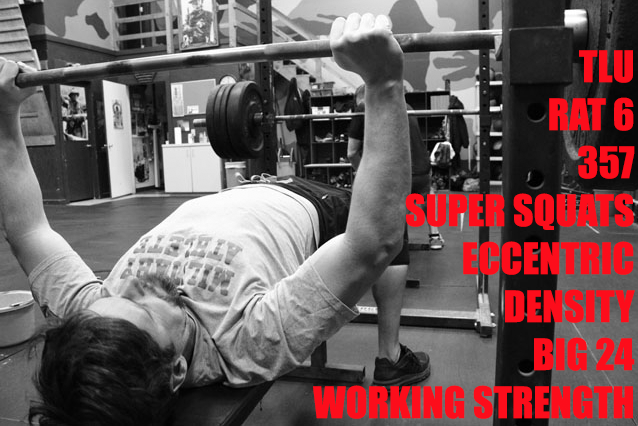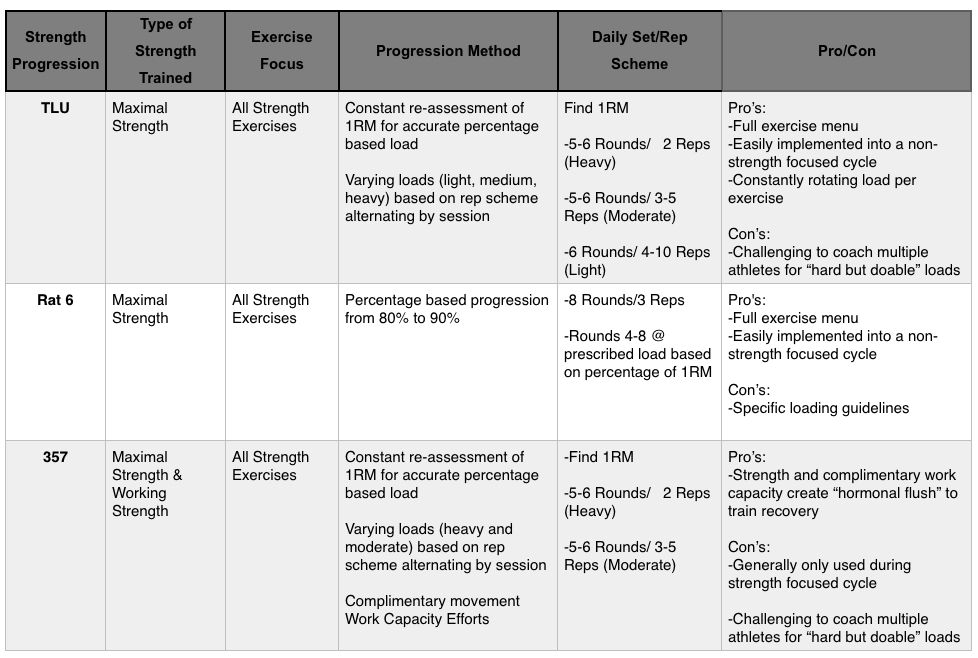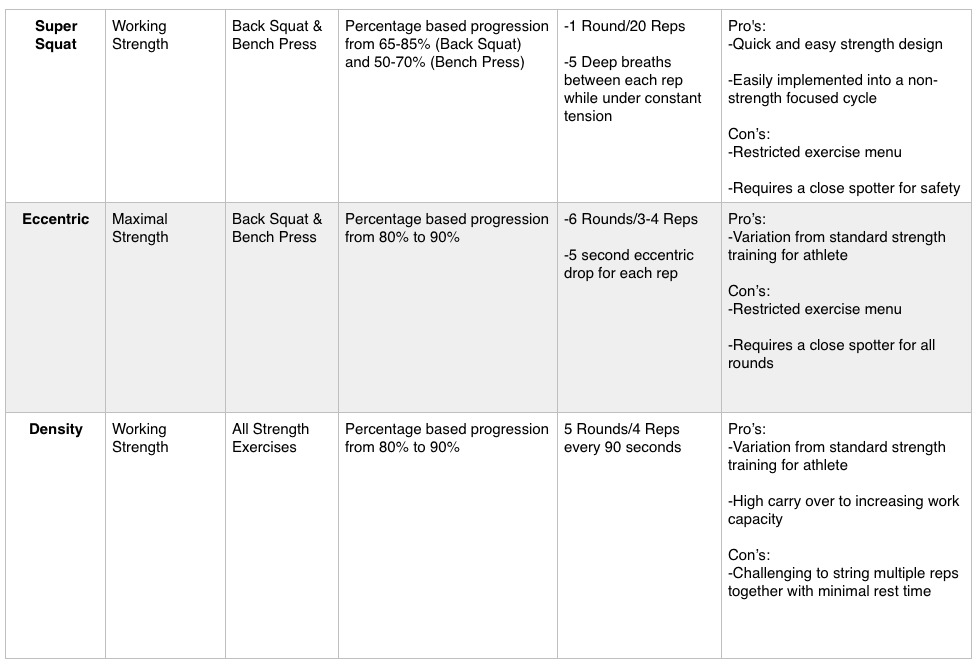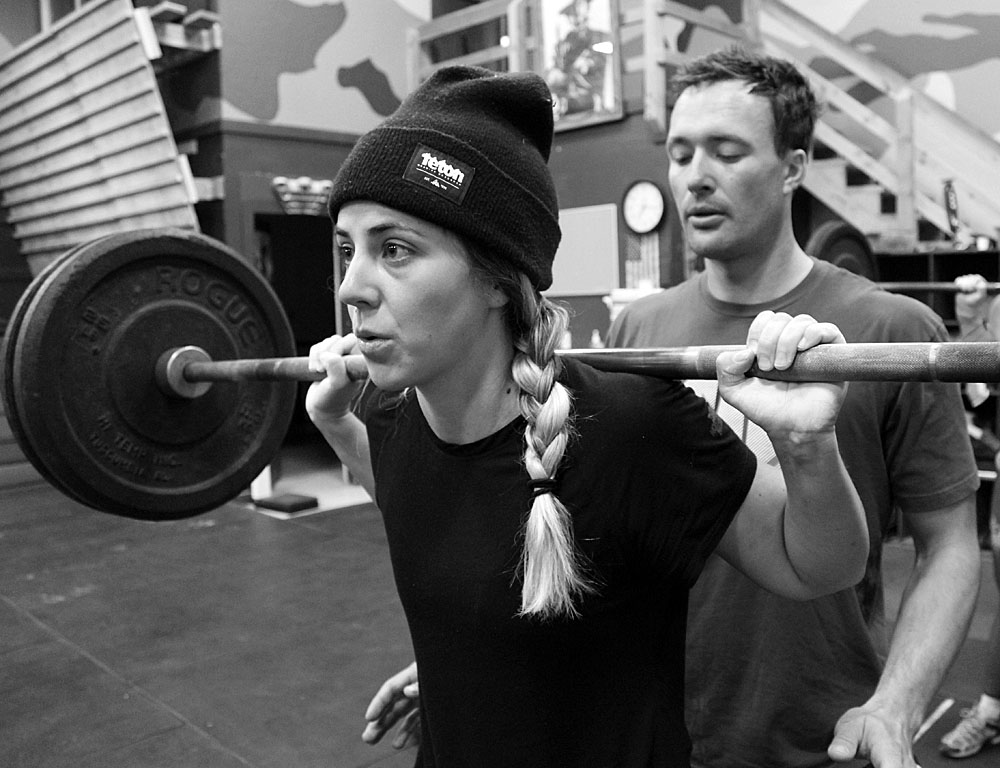
By Charles Bausman & Rob Shaul
Background and Process
When I began coaching in 1995 I would take other coaches’ strength progression design and apply to myself and athletes. I’d do what was printed, and find things that worked, and others that didn’t.
Next, I began to combine what worked from one coach, with what worked with another coach, into ‘hybrid’ designs.
Finally, after a few years of this and with a solid grasp of the theory behind strength session design, I began designing my own progressions from scratch. So far at MTI, we’ve deployed eight different strength progressions into our training plans … there are a few more to come. Always more work to do! – Rob Shaul
1) TLU Strength
Our classic strength progression, TLU stands for Total Body, Lower Body, and Upper Body. Within a TLU strength session, each component is trained (total, lower, upper) but with a differing intensity (loading) and volume (reps to per set and total reps per exercise). We’ve deployed TLU progression for years, and it continues to be our favorite for hybrid athletes like tactical and mountain athletes.
While we call it TLU, the session’s alternate the order evenly throughout a cycle (UTL, LUT, etc). For the first exercise, you will find your 1RM, followed by 5-6 Rounds of 2x @ 85% of 1RM. This is a heavy load, and total volume is 10-12 reps total.
The second exercise uses 6 rounds and 3-5 repetitions (18-30 reps total) at a “hard but doable” weight. It’s paired with an explosive bodyweight movement similar to the movement pattern of the lift, completed immediately after finishing the lift. A mobility movement finishes up the round and doubles as the rest period.
The third exercise has the highest volume, with 6 Rounds and 4-10 repetitions (24-60 reps total). Again, this is paired with a body weight movement and mobility for each round.
TLU progression is a way to train strength frequently, without overtraining. But best of all, TLU sessions are fun! There’s lots of variety, we add complex training to develop power and athleticism, and the entire body gets strength trained in one session.
More?
We have an online TLU Programming Course HERE.
Or Check out our TLU Strength Training Plan
2) Rat 6 Strength
Rat 6 is a percentage based strength progressions based upon 1RM’s. It can be applied to one exercise in any cycle, or used with several exercises in a focused strength cycle.
At the beginning of the cycle, the athlete will find his/her 1RM for the exercise. In following sessions, the athlete will complete 8 rounds of 3 reps. The first three rounds, the athlete works up in weight, until they are at 80% of their 1RM for the fourth round. Rounds 4-8 are all completed at this weight, with a mobility movement following each round.
As the cycle progresses, the athlete will progress up to 90% of their 1RM for Rounds 4-8, before re-assessing and re-setting the progression.
The best design is simple and direct, and Rat 6 fits this bill. Rat 6 Strength is a plan I frequently recommend to new lifters.
More?
Learn how to program design Rat 6 Strength with our online course HERE.
Or Check out our Rat 6 Strength Training Plan
3) 357 Strength
Similar to TLU strength progression, 357 Strength works through a 1RM and 85% 1RM for the working sets of the first heavy portion. It’s followed by a moderate load “hard but doable” effort.
The key to 357 Strength is the complementary work capacity effort. Varying in duration from 3 minutes, 5 minutes, to 7 minutes, these work caps utilize the same exercises conducted in the strength portion to create a “hormonal flush.” This shocks the body to overcompensate during recovery, resulting in greater gains than if the exercises were completed in the same volume, but with less intensity.
We first deployed 357 for one of our athletes who was competing in the CrossFit games. It’s since become a great strength progression for experienced athletes. We just updated our 357 Strength Plan HERE.
MTI’s Strength Progressions



4) Super Squat Strength
The Super Squat design is based on Dr. Strossel’s famous book, but with our significant lab rat-proven modifications. Super Squat’s focus is time under tension, completing 1 Round of 20 reps without racking or dropping the bar. The prescribed weight is percentage based, working up to 85% 1RM. Between each rep, the athlete takes 3 big, slow breaths. 20x reps generally take between 3-4 minutes of total time under the bar and is absolutely brutal. A close spotter is required and helps in the counting the reps for the lifter.
Despite the name, we’ve also done this with the Bench Press, although at a lower prescribed weight. The max we’ll work up to in a cycle for Bench is 70%.
More?
Learn how to program Super Squats Strength with our online course HERE.
Or Check out our Super Squat Strength Training Plan.

5) Eccentric Strength
The eccentric portion of a lift is the controlled movement down. Eccentric training requires the athlete to control the weight and slowly move downwards to the bottom of the squat, or slowly lowering the barbell to the chest. With our Eccentric Strength progression, we use a 5-second count for each rep.
We use a 6 Round, 3 Rep scheme with percentage based loading starting with 80% 1RM and ending with 90% 1RM. Each round, the athlete does the eccentric portion over five seconds to the bottom of the lift, and concentrically moves the weight up at normal speed.
Like the Super Squat, a good spotter is incredibly important in the event that the athlete gets “stuck” at the bottom.
We first deployed Eccentric progression with our professional skiers as another way to train the eccentric strength needed for alpine skiing. We used these pros as our “lab rats” and have since deployed eccentric progression with our tactical athletes.
More? Check out our MTI Eccentric Strength Plan
6) Density Strength
Density strength uses a 5 Round, 4 Rep scheme with each round completed in 90 seconds. This format trains our “working strength” – multiple reps with short recovery time and near maximal loading.
Weight is determined by 1RM percentage based loading, beginning with 80% 1RM and working up to 90% within the cycle. Each round the athlete has 90 seconds to complete the 4 reps, with the remainder of the time as rest. Once the 90 seconds is up, the athlete starts the next 90 second round. The faster you finish your reps, the more rest you get.
The “working strength” category has significant carryover to increasing overall work capacity for a variety of gym based and field-based fitness demands.
The MTI Relative Strength Assessment Training Plan deploys our Density Strength progression methodology.
7) Big 24
Completing the final two training sessions of a Big 24 cycle is the closest Rob has ever come to puking in the gym. Big 24 is intense and full on … simple and hard.
Instead of working up to 1RM, in Big 24 athletes work up to 3RM – or 3x repetition maximum in 6 classic strength exercises … Back Squat, Walking Lunge, Hang Squat Clean (Day 1) and Bench Press, Pull Ups (max reps), and Push Press (Day 2).
Follow-on set rep schemes are 8 Rounds of 3 reps (8×3 – 24, hence the name). In the first follow-on progression, the athlete drops 10# from his/her 3RM and completes rounds 4-8 at that load (5 Rounds total). In the second progression, the athlete drops just 5# from his/her 3RM and completes rounds 4-8 at that load. In the final progression, the athlete completes rounds 4-8 at his/her 3RM… then they re-assess and start the progression all over again.
We’ve deployed Big 24 progression for the strength component in many mountain and tactical training cycles over the years. Click HERE for our focused Big 24 Strength plan.
More? Click HERE for our online Big 24 Strength Design Course.
8) Working Strength
MTI’s Working Strength Progression is our latest and newest strength progression.
The set/rep scheme is based on our existing Density Strength progression – which deploys an interval clock, and percentage-based progression based on a 1RM. Density Strength has been a proven strength builder for us over the years.
Rob and the other “old guy” lab rats (40 years plus) tested this variation of density training in one of our Geek Cycles.
What’s exciting about this is the possibility of maintaining solid strength with very little volume – great to reduce overall impact, perfect for endurance athletes, and hopefully, another great way to add strength without weight gain.
Click HERE for more on the Geek Cycle or Here for the matching Plan.
Questions, Comments, Feedback? Email coach@mtntactical.com
STAY UPDATED
Sign-up for our BETA newsletter. Training tips, research updates, videos and articles - and we’ll never sell your info.
